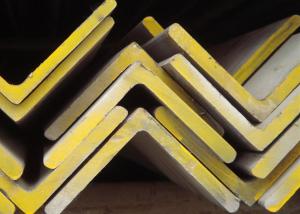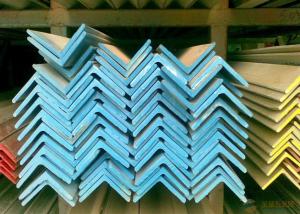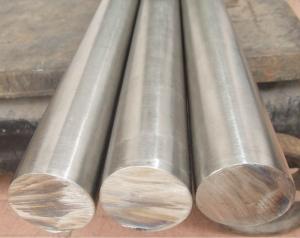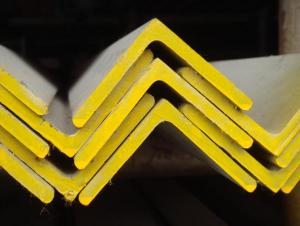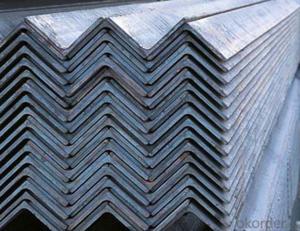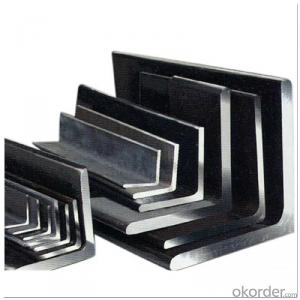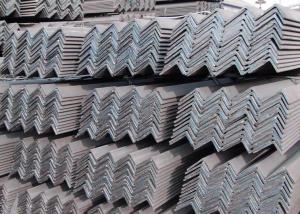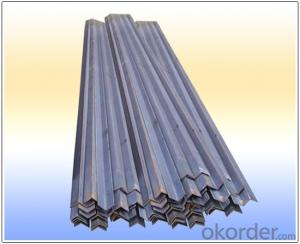Best Quality for 304 Stainless Steel Angles
- Loading Port:
- China Main Port
- Payment Terms:
- TT or LC
- Min Order Qty:
- 1 Ton m.t.
- Supply Capability:
- 500 Tons Per Month m.t./month
OKorder Service Pledge
OKorder Financial Service
You Might Also Like
Stainless Steel Angles
General Information of Stainless Steel Angles
1. Grade: SS200, 300,400 series
2. Size: 25×25×3 mm-100×100×10mm
3. Process: HRAP
4. Length: 2-6m
5. Shape: Equal
6. Delivery: within 20 days
7. MOQ: 1 ton
8. Certificate: ISO 9001:2008, SGS
9. Package: Standard Export Packing, or put into wooden boxes according to your requirement
10. Application: Construction, Marine, Industry and so on.
Specification of Stainless Steel Angles
Name | Stainless Steel Angles | |||||
Standard | ASTM A554, A312, A249, A269 and A270 | |||||
Material Grade | 304,316,201,202, 316L,430 | |||||
Length | 6m or as customers' request | |||||
Tolerance | a) Thickness: +/-0. 15mm | |||||
b) Length: +/-4. 5mm - 0mm | ||||||
Surface | 180G, 320G, 400G Satin / Hairline(Matt Finish, Brush, Dull Finish) 400G, 500G, 600G or 800G Mirror finish | |||||
Application | Decoration construction, upholstery, industry instruments | |||||
Test | Squash test, Extended test, Water pressure test, Crystal rot test, Heat treatment, NDT | |||||
Chemical Composition of Material | Composition Material | 201 | 202 | 304 | 316 | 430 |
C | ≤0.15 | ≤0.15 | ≤0.08 | ≤0.08 | ≤0.12 | |
Si | ≤1.00 | ≤1.00 | ≤1.00 | ≤1.00 | ≤1.00 | |
Mn | 5.5-7.5 | 7.5-10 | ≤2.00 | ≤2.00 | ≤1.00 | |
P | ≤0.06 | ≤0.06 | ≤0.045 | ≤0.045 | ≤0.040 | |
S | ≤0.03 | ≤0.03 | ≤0.030 | ≤0.030 | ≤0.030 | |
Cr | 16-18 | 17-19 | 18-20 | 16-18 | 16-18 | |
Ni | 3.5-5.5 | 4-6 | 8-10.5 | 10-14 | ||
Mo | 2.0-3.0 | |||||
Mechanical Property | Material Item | 201 | 202 | 304 | 316 | |
Tensile Strength | ≥535 | ≥520 | ≥520 | ≥520 | ||
Yield Strength | ≥245 | ≥205 | ≥205 | ≥205 | ||
Extension | ≥30% | ≥30% | ≥35% | ≥35% | ||
Hardness (HV) | <253 | <253 | <200 | <200 | ||
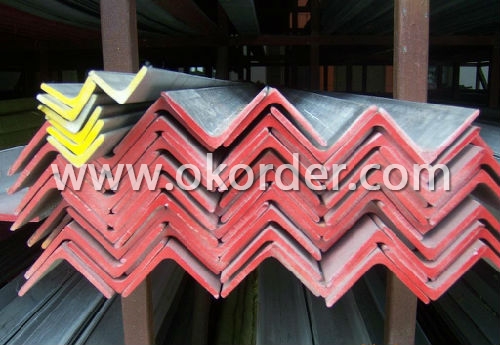
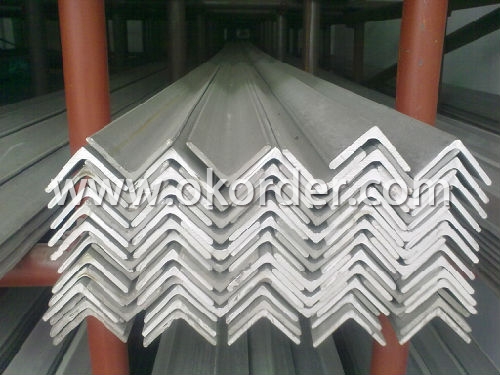
- Q:How do you clean and maintain stainless steel angles?
- Cleaning and maintaining stainless steel angles is relatively simple and requires minimal effort. Here are some steps you can follow: 1. Start by wiping the surface of the stainless steel angle with a soft cloth or sponge dipped in warm water. This will help remove any loose dirt or debris. 2. If there are any stubborn stains or grease marks, you can use a mild detergent or stainless steel cleaner. Apply the cleaner to a soft cloth or sponge and scrub gently in the direction of the grain. Avoid using abrasive cleaners or scrub brushes as they can scratch the surface. 3. After cleaning, rinse the stainless steel angle with clean water to remove any residue from the cleaner. 4. For tougher stains or baked-on grease, you can make a paste of baking soda and water. Apply the paste to the affected area and let it sit for a few minutes. Then, scrub gently with a soft cloth or sponge and rinse thoroughly. 5. To maintain the shine and luster of the stainless steel angle, you can use a stainless steel polish or a homemade solution of vinegar and water. Apply the polish or vinegar solution to a clean, soft cloth and buff the surface in the direction of the grain. 6. It is important to avoid using abrasive materials, such as steel wool or harsh scrub brushes, as they can scratch and damage the stainless steel surface. Also, avoid using chlorine-based cleaners or bleach, as they can cause discoloration. 7. Regularly wiping the stainless steel angle with a soft cloth or sponge and warm water will help prevent the buildup of dirt and grime, making the cleaning process easier. By following these simple steps, you can keep your stainless steel angles looking clean, shiny, and well-maintained for years to come.
- Q:What are the thermal conductivity properties of stainless steel angle?
- Stainless steel angle has relatively low thermal conductivity properties compared to other metals. The thermal conductivity of stainless steel angle varies depending on the specific grade of stainless steel used, as well as other factors such as the temperature and thickness of the angle. In general, stainless steel has a thermal conductivity ranging from 16 to 30 watts per meter-kelvin (W/mK), which is lower than metals like copper or aluminum. This means that stainless steel angle is not as efficient in transferring heat as these other metals. However, stainless steel angle is still commonly used in applications requiring good corrosion resistance and strength, where thermal conductivity may not be the primary concern.
- Q:What is the fatigue strength of stainless steel angles?
- The fatigue strength of stainless steel angles can vary depending on factors such as the grade of stainless steel, the specific angle design, and the surface finish. Generally, stainless steel has good fatigue strength due to its high strength and resistance to corrosion. However, for more precise information, it is recommended to consult the specific material specifications or conduct fatigue testing.
- Q:What are the different types of stainless steel angle profiles?
- Some of the different types of stainless steel angle profiles include equal leg angles, unequal leg angles, rounded inside corners, and sharp inside corners. These profiles vary in their dimensions and are used for various applications in construction, manufacturing, and architectural industries.
- Q:Can stainless steel angles be used in the production of equipment for the food industry?
- Stainless steel angles are indeed suitable for the manufacturing of food industry equipment. Their corrosion-resistant properties make stainless steel a favored choice in this sector, as it can withstand exposure to food and cleaning chemicals. Moreover, stainless steel angles offer structural support and stability when constructing conveyor systems, food processing machinery, and storage racks. Furthermore, stainless steel is effortless to clean and maintain, reducing the chances of contamination and upholding high hygiene standards in food production facilities. In conclusion, stainless steel angles are widely utilized and well-suited for the production of food industry equipment.
- Q:What is the resistance to corrosion of stainless steel angles?
- Stainless steel angles have a high resistance to corrosion due to the presence of a protective layer of chromium oxide on their surface. This oxide layer forms when chromium in the steel reacts with oxygen in the atmosphere, creating a passive film that prevents further oxidation and corrosion. This passive film is self-healing, meaning that if it is damaged, it can reform and continue to protect the underlying steel. Additionally, stainless steel angles often contain other alloying elements such as nickel and molybdenum, which further enhance their corrosion resistance. Overall, stainless steel angles are highly resistant to corrosion, making them suitable for various applications in industries such as construction, architecture, and marine environments.
- Q:What is the difference between 304 and 316 stainless steel angles?
- The main difference between 304 and 316 stainless steel angles lies in their composition and the presence of certain elements. 304 stainless steel is a versatile and widely used stainless steel alloy that contains chromium and nickel. It is known for its excellent corrosion resistance, high durability, and ease of fabrication. However, 304 stainless steel angles are not as resistant to corrosion as 316 stainless steel angles in certain environments, such as marine or highly corrosive settings. On the other hand, 316 stainless steel angles are a higher grade alloy that contains additional elements, such as molybdenum, which enhances their corrosion resistance. This makes them particularly suitable for applications where exposure to chloride-based substances, acids, or high salinity is expected. 316 stainless steel angles are commonly used in marine environments, chemical processing plants, and medical equipment. In terms of appearance, both 304 and 316 stainless steel angles have a similar look and finish. However, 316 stainless steel angles may have a slightly higher luster due to the presence of additional elements. To summarize, while both 304 and 316 stainless steel angles offer good corrosion resistance and durability, 316 stainless steel angles are better suited for applications where higher levels of resistance to corrosion and pitting are required, especially in harsh or corrosive environments.
- Q:What are the seismic resistance properties of stainless steel angles?
- Stainless steel angles have excellent seismic resistance properties due to their high strength, durability, and corrosion resistance. They provide structural stability and can withstand strong seismic forces, making them suitable for applications in earthquake-prone areas.
- Q:What are the different surface textures available for stainless steel angles?
- Stainless steel angles, also known as stainless steel L-shaped bars, can have various surface textures depending on the specific requirements and desired appearance. Some of the common surface textures available for stainless steel angles are: 1. Hot rolled: This is the most common surface texture for stainless steel angles. It is achieved by heating the steel to high temperatures and then rolling it to the desired shape and size. Hot rolled stainless steel angles have a rougher texture with a slightly scaled surface due to the heat treatment process. 2. Cold drawn: This surface texture is achieved by cold working the stainless steel angle through a series of processes such as drawing, annealing, and straightening. Cold drawn stainless steel angles have a smoother and more polished appearance compared to hot rolled angles. 3. Sanded: Stainless steel angles can undergo sanding or brushing processes to achieve a uniform and smooth surface texture. This is often done to improve the aesthetics of the angle and to remove any imperfections or scratches. 4. Polished: Polished stainless steel angles have a highly reflective and mirror-like surface texture. This is achieved through mechanical polishing or buffing using abrasive materials or compounds. Polished stainless steel angles are commonly used in decorative applications where a shiny and elegant finish is desired. 5. Bead blasted: Bead blasting is a surface treatment process in which small glass beads or other abrasive materials are shot onto the stainless steel angle at high pressure. This creates a uniform and matte texture with a slightly roughened surface. 6. Etched: Etching is a chemical process used to create decorative patterns or designs on the surface of stainless steel angles. This surface texture can be achieved by applying an acid-resistant mask on the angle and then applying acid to remove the unprotected areas, leaving behind the desired pattern or design. These are just a few examples of the different surface textures available for stainless steel angles. The choice of texture depends on the intended application, desired appearance, and specific requirements such as corrosion resistance or ease of cleaning.
- Q:What are the different types of edge finishes for perforated stainless steel angles?
- Perforated stainless steel angles come in various edge finishes, each with its own advantages and aesthetic appeal. One popular choice is a straight or square edge, which gives a neat and sharp appearance, perfect for achieving a simple and minimalist look. Another option is the rounded or bullnose edge finish, which adds a curved and smooth touch. This not only enhances the visual appeal but also ensures safety by eliminating any sharp edges that could potentially cause harm. Bullnose edges are commonly used in architectural and interior design applications, where a softer and more polished look is desired. For those seeking a touch of sophistication, a beveled edge finish is available. This type of edge has an angled cut, creating a sloping or chamfered edge. Beveled edges are often chosen for high-end architectural projects that require attention to detail. Furthermore, a hemmed edge finish provides a smooth and rounded edge by folding the angle's edge over itself. This option is particularly suitable for applications where safety is a concern, as it eliminates any sharp edges that could potentially cause harm. Lastly, a decorative edge finish allows for customization and artistic expression. This can include custom designs, patterns, or laser-cut shapes along the edge of the angle. Decorative edge finishes are commonly used in creative and artistic projects, such as signage or decorative panels. In conclusion, the range of edge finishes available for perforated stainless steel angles offers options to suit various design preferences and functional requirements. Whether one desires a clean and sharp look, a soft and rounded edge, or an intricate decorative finish, there is an edge finish suitable for every project.
1. Manufacturer Overview |
|
|---|---|
| Location | Zhejiang, China |
| Year Established | 2010 |
| Annual Output Value | above US$16 million |
| Main Markets | East Asia, Middle East. |
| Company Certifications | |
2. Manufacturer Certificates |
|
|---|---|
| a) Certification Name | |
| Range | |
| Reference | |
| Validity Period | |
3. Manufacturer Capability |
|
|---|---|
| a)Trade Capacity | |
| Nearest Port | Shanghai |
| Export Percentage | |
| No.of Employees in Trade Department | above 10 people |
| Language Spoken: | English, Chinese |
| b)Factory Information | |
| Factory Size: | about 30000 square meter |
| No. of Production Lines | above 7 |
| Contract Manufacturing | OEM Service Offered |
| Product Price Range | Average |
Send your message to us
Best Quality for 304 Stainless Steel Angles
- Loading Port:
- China Main Port
- Payment Terms:
- TT or LC
- Min Order Qty:
- 1 Ton m.t.
- Supply Capability:
- 500 Tons Per Month m.t./month
OKorder Service Pledge
OKorder Financial Service
Similar products
New products
Hot products
Hot Searches
Related keywords
